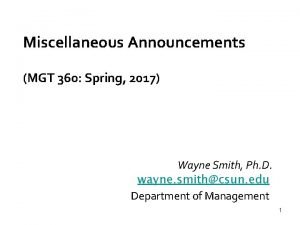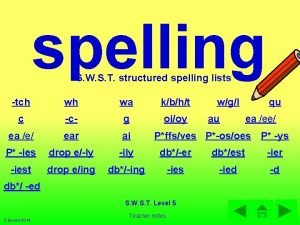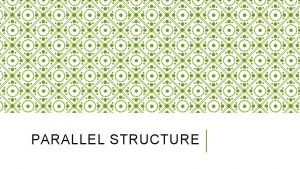CSc 110 Spring 2017 Lecture 26 Lists of

![List of lists mystery def mystery(data, pos, n): result = [] for i in List of lists mystery def mystery(data, pos, n): result = [] for i in](https://slidetodoc.com/presentation_image_h2/59be95314093baa1bca0a0bbc965bf86/image-2.jpg)



![[ [34, 76, 87, 9, 34, 8, 22, 33, 33, 45, 65, 43, 22] [ [34, 76, 87, 9, 34, 8, 22, 33, 33, 45, 65, 43, 22]](https://slidetodoc.com/presentation_image_h2/59be95314093baa1bca0a0bbc965bf86/image-6.jpg)
![[ [34, 76, 87, 9, 34, 8, 22, 33, 33, 45, 65, 43, 22] [ [34, 76, 87, 9, 34, 8, 22, 33, 33, 45, 65, 43, 22]](https://slidetodoc.com/presentation_image_h2/59be95314093baa1bca0a0bbc965bf86/image-7.jpg)












- Slides: 19

CSc 110, Spring 2017 Lecture 26: Lists of Lists 1
![List of lists mystery def mysterydata pos n result for i in List of lists mystery def mystery(data, pos, n): result = [] for i in](https://slidetodoc.com/presentation_image_h2/59be95314093baa1bca0a0bbc965bf86/image-2.jpg)
List of lists mystery def mystery(data, pos, n): result = [] for i in range(0, n): for j in range(0, n): result. append(data[i + pos][j + pos]) return result Suppose that a variable called grid has been declared as follows: grid = [[8, 2, 7, 8, 2, 1], [1, 5, 1, 7, 4, 7], [5, 9, 6, 7, 3, 2], [7, 8, 7, 7, 7, 9], [4, 2, 6, 9, 2, 3], [2, 2, 8, 1, 1, 3]] Function Call Contents of List Returned which means it will store the following 6 -by-6 grid of values: 8 2 7 8 2 1 mystery(grid, 2, 2) ______________ 1 5 1 7 4 7 5 9 6 7 3 2 mystery(grid, 0, 2) ______________ 7 8 7 7 7 9 4 2 6 9 2 3 mystery(grid, 3, 3) ______________ 2 2 8 1 1 3 For each call at right, indicate what value is returned. If the function call results in an error, write error instead. 2

Find Lucky 7 Write a function lucky(m)that takes a rectangular list m and looks for the number 7 in m. If found, lucky returns a list containing the row and column position of 7, and if not found, returns an empty list. Example: z = [[20, 3, 6], [4, 12, 18], [6, 13, 5], [15, 7, 8]] lucky(z) Returns [3, 1] 3

Mountain peak Write a program that reads elevation data from a file, draws it on a Drawing. Panel and finds the path from the highest elevation to the edge of the region. Data: 34 76 87 9 34 8 22 33 33 33 45 65 43 22 5 7 88 0 56 76 76 77 4 45 55 55 4 5 … 4

Mountain peak Consider the data: 34 76 87 9 34 8 22 33 33 33 45 65 43 22 5 7 88 0 56 76 76 77 4 45 55 55 4 5 … Each line is a row of elevations we will create a list of lists of elevations First steps: 1) create a mapping of the data representation to Drawing. Panel components 2) read in the data 3) draw an image of the elevation data using Drawing. Panel components 5
![34 76 87 9 34 8 22 33 33 45 65 43 22 [ [34, 76, 87, 9, 34, 8, 22, 33, 33, 45, 65, 43, 22]](https://slidetodoc.com/presentation_image_h2/59be95314093baa1bca0a0bbc965bf86/image-6.jpg)
[ [34, 76, 87, 9, 34, 8, 22, 33, 33, 45, 65, 43, 22] [5, 7, 88, 0, 56, 76, 77, 4, 45, 55, 4, 5] … ] Each row becomes a row of rectangles in the Drawing. Panel Each rectangle is 1 pixel wide If the mountain data is stored in a list of lists data, how large do we make the Drawing. Panel? p = Drawing. Panel( width ? ? , height ? ? ) 6
![34 76 87 9 34 8 22 33 33 45 65 43 22 [ [34, 76, 87, 9, 34, 8, 22, 33, 33, 45, 65, 43, 22]](https://slidetodoc.com/presentation_image_h2/59be95314093baa1bca0a0bbc965bf86/image-7.jpg)
[ [34, 76, 87, 9, 34, 8, 22, 33, 33, 45, 65, 43, 22] [5, 7, 88, 0, 56, 76, 77, 4, 45, 55, 4, 5] … ] Each row becomes a row of rectangles in the Drawing. Panel Each rectangle is 1 pixel wide The elevation is mapped to a level of black or white, a shade of grey, creating a greyscale image: white is weakest (higher in elevation) black is strongest (lower in elevation) p. canvas. create_rectangle(x, y, x + 1, y + 1, outline=map elevation to a shade of grey) 7

Mapping indices to arguments data = [ [34, 76, 87, 9, 34, 8, 22, 33, 33, 45, 65, 43, 22] [5, 7, 88, 0, 56, 76, 77, 4, 45, 55, 4, 5]. . . ] For the first row: p. canvas. create_rectangle(0, p. canvas. create_rectangle(1, p. canvas. create_rectangle(2, p. canvas. create_rectangle(3, . . 0, 0, 1, 2, 3, 4, 1, 1, outline = = color of of 34) 76) 87) 9) 8

Mapping to indices to arguments data = [ [34, 76, 87, 9, 34, 8, 22, 33, 33, 45, 65, 43, 22] [5, 7, 88, 0, 56, 76, 77, 4, 45, 55, 4, 5]. . . ] for row in range(0, len(data)): for col in range(0, len(data[row])): color = get_color(data[row][col]) p. canvas. create_rectangle(col, row, col + 1, row + 1, outline = color) p. canvas. create_rectangle(0, p. canvas. create_rectangle(1, p. canvas. create_rectangle(2, p. canvas. create_rectangle(3, . . . 0, 0, 1, 2, 3, 4, 1, 1, outline = = color of 34 -- data[0][0]) of 76 -- data[0][1]) of 87 -- data[0][2]) of 9 -- data[0][3]) 9

2) Read in the data from drawingpanel import * from random import * def main(): file = open("mountaindata. dat") lines = file. readlines() data = [] for line in lines: data. append(line. split()) p = Drawing. Panel(len(data[0]), len(data)) draw_image(p, data) 10

3) Draw the elevation image # draws the passed in data on the passed in drawing panel. # The data is a list of lists of numbers representing # elevation data. def draw_image(p, data): for row in range(0, len(data)): # data[row] -> [3, 5, 76, 3] for col in range(0, len(data[row])): color = get_color(int(data[row][col])) p. canvas. create_rectangle(col, row, col + 1, row + 1, outline=color) 11

Mountain peak data = [ [34, 76, 87, 9, 34, 8, 22, 33, 33, 45, 65, 43, 22] [5, 7, 88, 0, 56, 76, 77, 4, 45, 55, 4, 5]. . . ] Next steps: 4) Find the peak 5) Find the steepest path down 6) Draw the path in yellow 12

4) Find the peak data = [ [34, 76, 87, 9, 34, 8, 22, 33, 33, 45, 65, 43, 22] [5, 7, 88, 0, 56, 76, 77, 4, 45, 55, 4, 5]. . . ] Find the largest elevation in the list of lists. Write find_peak(data) Return a tuple of the location in the 2 d list 13

5) Find the steepest path data = [['2537', ['2541', ['2525', ['2514', ['2506', ['2527', ['2544', ['2528', ['2464', ['2532', '2483', '2549', '2525', '2505', '2482', '2477', '2505', '2486', '2505', '2541', '2475', '2614', '2640', '2526', '2480', '2464', '2488', '2464', '2482', '2519', '2480', '2700', '2769', '2614', '2528', '2459', '2454', '2446', '2456', '2515', '2518', '2647', '2802', '2717', '2518', '2452', '2442', '2434', '2433', '2496', '2532', '2746', '2883', '2715', '2561', '2475', '2445', '2436', '2463', '2502', '2480', '2690', '2856', '2867', '2586', '2480', '2446', '2442', '2462', '2529', '2478', '2621', '2694', '2836', '2662', '2500', '2467', '2444', '2489', '2519', '2431'] '2550'] '2631'] '2771'] '2654'] '2518'] '2470'] '2450'] '2467'] '2553']] How do we determine the steepest path? We would need to compare the peak to each neighbor. 14

5) Find the steepest path down data = [['2537', ['2541', ['2525', ['2514', ['2506', . . . ] '2483', '2549', '2525', '2505', '2482', '2475', '2614', '2640', '2526', '2480', '2700', '2769', '2614', '2528', '2518', '2647', '2802', '2717', '2518', '2532', '2746', '2883', '2715', '2561', '2480', '2690', '2856', '2867', '2586', We will simplify this problem. Look at only three neighbors: up down front If peak is at location data[r][c], define each above. '2478', '2621', '2694', '2836', '2662', '2431'] '2550'] '2631'] '2771'] '2654']] 15

5) Find the steepest path down data = [['2537', '2483', '2475', '2480', '2518', '2532', '2480', '2478', '2431'] ['2541', '2549', '2614', '2700', '2647', '2746', '2690', '2621', '2550'] ['2525', '2640', '2769', '2802', '2883', '2856', '2694', '2631'] ['2514', '2505', '2526', '2614', '2717', '2715', '2867', '2836', '2771']. . . ] Compare and find the smallest of the three to create the next path element. What happens if there are ties? 16

5) Find the steepest path down Rules for ties. If up == down but < front, choose randomly between them. up = 2550 down = 2550 front = 2690 If front ties with up or down, choose front. up = 2690 up = 2550 down = 2690 front = 2550 17

5) Pseudocode for find_path initialize current location (this is both a row and column) make an empty list for path while location is still within the list bounds assign up, front and down if (up < down and down < front) append up location to path else if (down < up and down < front) append down location to path else if (down == up and up < front) chose randomly between down and up append one of them to path else append front location to path update current location based on the chosen next location for path return path 18

6) Pseudocode for draw_path For each tuple in the path Using the column and row given in the tuple, draw a rectangle that is one pixel wide and filled in with yellow 19
 Où se trouve le numéro d'affiliation mutuelle vignette ?
Où se trouve le numéro d'affiliation mutuelle vignette ? 100 011
100 011 Csc 110 university of arizona
Csc 110 university of arizona 01:640:244 lecture notes - lecture 15: plat, idah, farad
01:640:244 lecture notes - lecture 15: plat, idah, farad Ftp server spring 2017
Ftp server spring 2017 Csun spring 2017
Csun spring 2017 Four seasons korean movie
Four seasons korean movie Which months are in spring
Which months are in spring Swst spelling lists level 5
Swst spelling lists level 5 Swot analysis customer service example
Swot analysis customer service example Wish lists year
Wish lists year Java types of lists
Java types of lists Wish lists year
Wish lists year Lesson 3: lists practice
Lesson 3: lists practice Political wish lists
Political wish lists Parallel list
Parallel list Resource lists edinburgh
Resource lists edinburgh Blockly c
Blockly c Political lists new
Political lists new Words their way
Words their way





































